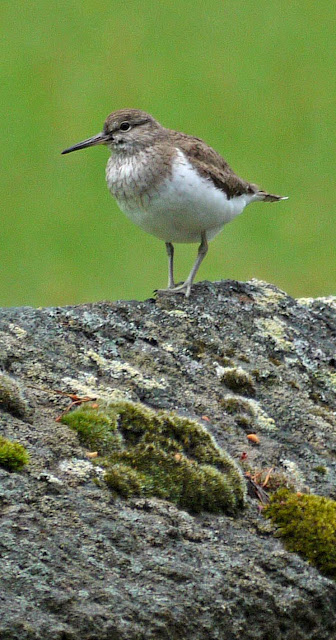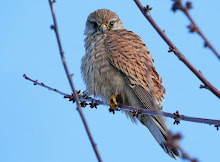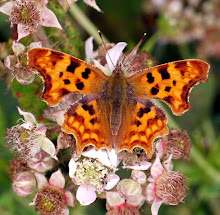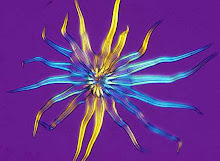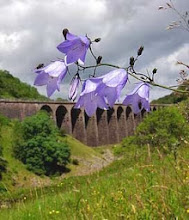Saturday, June 30, 2012
Common
Buttercups are amongst the commonest of all wild flowers and tend to be taken for granted because of that, but they represent a vital, reliable resource for wildlife at the bottom of the food chain. All that pollen supplies food for an amazing array of small insects.
This young earwig, was nibbling buttercup petals....
............ while this unidentified beetle was feeding on the stamens........
.... and this hoverfly was making a meal of the pollen.
Understandably, naturalists tend to be obsessed with rarities, but it's the common stuff that's really important when it comes to maintaining the stability of ecosystems.
Labels:
Beetles,
buttercups,
earwig,
Flies,
hoverflies
Friday, June 29, 2012
Yellow Jellyspot
At least some fungi seem to be benefiting from the dismal, muggy wet weather. This common jellyspot Dacrymyces stillatus is thriving on the permanently wet wood of an old cable drum that doubles as our garden table. Currently, it's just about the brightest living object in the garden.
Labels:
common jellyspot,
Dacrymyces stillatus,
fungi
Thursday, June 28, 2012
Must Remember not to hit F10....
This little zebra spider always appears mid-morning while I'm working on my computer, lowering itself down from the desk lamp and making lively jumps across the keyboard. All the time that it sticks to the dusty keys that I don't use much, like F10, it'll be safe. I presume it's the same one that I photographed on the window ledge back in January, although it has certainly grown a bit since then.
Labels:
spiders,
Zebra spider
Tuesday, June 26, 2012
Washday Wasp
This little digger wasp took fancy to our washing on the washing line yesterday. There are quite a few very similar looking species but I'd hazard a guess that this might be a female Crabro cribrarius. There's a picture of a male, with spade-shaped front legs , here.
The smooth, almost hemispherical eyes are particularly striking.
Sunday, June 24, 2012
Transformers
Drone fly larvae, commonly known as rat-railed maggots, possess one of the most amazing pieces of equipment found in any insect larva. They live in waterlogged soil or shallow water around the margin of ponds, where the water level can rise and fall all the time - especially in a wet summer like the one we are enduring now.
The long tail is the insect equivalent of a submarine snorkel, with muscles that allow it to shorten or elongate so that the tip of the tube is always level with the water surface.
At this stage in their life cycle they may not be high on aesthetic appeal but when they metamorphose they transform ...........
...............into one of these
A life that starts in stagnant mud becomes a drone fly, hovering in a sunbeam on a sunny afternoon.
Labels:
diptera,
drone fly,
Eristalis tenax,
Flies,
insects,
Rat-tailed maggot
Saturday, June 23, 2012
Nectar Nicked
A couple of days ago I posted some pictures of bumblebees stealing nectar from columbine flowers without pollinating them. They're at it again, this time on my broad beans.
This is a well-behaved bumblebee, showing how it should be done. The bee lands on the flower and pushes its head into the gap between the standard petal and the wing and keel petals below, reaching out with its tongue towards the nectar in the corolla tube behind the petals.
This requires a lot of physical effort on the part of the bee, and in forcing its tongue towards the hidden nectar it also forces down the two wing petals (with the black blotches on them) and springs the stigma and stamens from the keel petal that encloses them. The half-full pollen baskets show that this industrious bee is also collecting pollen for the brood, as well as satisfying its own energy requirements with a drink of nectar; textbook behaviour.
After the bee leaves the flower should look like this, with the stamens and stigma tripped and protruding from the enclosing keel petal, with pollen forced onto the surface of the stigma so that there's every chance that a broad bean pod will now develop.
And here's the sneaky way to extract nectar without all the effort required to trip the flower - simply by biting through the corolla tube and poking your proboscis through the hole. This bee seems to have no pollen baskets so I think it may be a cuckoo bee, stealing nectar wherever it can find it, leaving the flower untripped. I don't suppose I'll be picking many beans from this plant.
Labels:
broad bean,
bumblebees,
nectar theft,
pollination,
Vicia faba
Friday, June 22, 2012
Late breeder
This family of newly-hatched lapwing chicks was foraging on moorland near the village of Woodland in Teesdale a couple of days ago. Lapwings normally nest in April and have fledglings that would be ready to fly by now. Maybe something destroyed these parents' first nest, or perhaps the bad weather in Spring meant that they needed to try again. Lapwings normally only raise a single brood.
Like many waders, lapwing chicks are mobile from the minute they hatch - little bundles of fluff on outsized legs and feet. Beautifully camouflaged too, as they foraged across this pile of grit and rubble beside the road. When they're not moving they are very hard to spot, although the alarm calls of an anxious parent let you know they're around somewhere.
Here's a more typical fledgling for this time of year, from an April brood, foraging on the same day for insects and worms in a very boggy corner of a pasture near Mickleton in Teesdale, which it was sharing with this...
.... magnificent beast.
Thursday, June 21, 2012
Theft in the flower border
Columbines are awkward flowers for bees to visit. They can reach the pollen by hanging from the stamens that dangle from below the flower, but the nectar is only accessible to insects with very long tongues. The nectar is secreted from the tip of those tall, tubular nectar spurs above the downward-pointing flower.
But within a few hours of opening all the nectar spurs in the columbines in my garden have holes ripped in them ............... and here....
..... is the culprit. Bumblebees must be able to smell the nectar inside the nectar spurs and quickly learn to short-circuit the legitimate route for extracting it, by simply using their powerful jaws to chew a hole in the nectar spur. Then it's easy to use their short tongue to suck out the nectar.
It always seems to be nectar-thieving bumblebees that chew the holes but honeybees soon learn to use this breach in the flower's security system.
When the columbines have finished flowering the devious bumblebees turn their attention to thieving nectar from broad beans, by chewing holes in the back of the corolla tube and so avoiding the effort and wear-and-tear that's involved in forcing their way between the petals at the front of the flower.
More items on flower pollination here.
More items on bumblebees here.
It always seems to be nectar-thieving bumblebees that chew the holes but honeybees soon learn to use this breach in the flower's security system.
When the columbines have finished flowering the devious bumblebees turn their attention to thieving nectar from broad beans, by chewing holes in the back of the corolla tube and so avoiding the effort and wear-and-tear that's involved in forcing their way between the petals at the front of the flower.
More items on flower pollination here.
More items on bumblebees here.
Labels:
Aquilegia,
bumblebees,
Columbine,
honeybee,
nectar theft,
pollination
Wednesday, June 20, 2012
Wildlife Viewed Through Beer Goggles: Stinging Nettles
My exploration of wildlife-themed beers has stalled a bit recently but here's an interesting example, brewed with additional stinging nettle flavouring, which adds a frisson of excitement to a quiet pint. Here's what the brewer, based at Matfen in Northumberland, says about it:
Nettle Ale 4.5% ABV
This ale can only be produced in the Spring, when the nettles on the farm are at the perfect stage to be picked. Based on a 14th century recipe, this ale is supposed to help the common cold and gout!
I haven't had a cold since I drank this and I haven't got gout (yet), so it clearly does exactly what it says on the bottle.
Stinging nettles are famous for the wealth of wildlife that they support, including numerous insects, of which thetiny nettle tap moth Anthophila fabriciana (above) is one, currently breeding on the nettles in my garden.
More wildlife-themed beers here.
Tuesday, June 19, 2012
A Beautiful Menace
This colourful display of Rhododendrom ponticum fills a little valley between the high pastures and the moorland to the south of Wolsingham in Weardale. The plants almost certainly originated in the grounds of the nearby St. John's hall, once the home of the Backhouse family who were bankers, tree planters and horticulturists who became famous as producers of new daffodil cultivars. The progeny of their old daffodil varieties fill the grounds around the hall in spring and at this time of year Rhododendron blooms that were once merely decorations beside the long drive leading up to the house fill the woodlands and these little moorland edge valleys. There would probably be more of them, but for the incredibly high rabbit population hereabouts that must limit the establishment of seedlings.
R. ponticum was introduced into Britain from Spain in 1763 and soon became popular with owners of large houses with extensive grounds. Cragside, home of Lord Armstrong in Northumberland, is still famous for its Rhododendron display.
Unfortunately the plant is very invasive and has been colonising woodlands and sheltered valleys on acid soils ever since it first escaped into the wild in 1894, smothering all natural vegetation of lesser stature in its dense , evergreen shade. The genus is noted for its interspecific hybrids, many of great garden merit, and in some parts of Britain R.ponticum seems to have hybridised with the North American species R.catawbiense, producing offspring with even greater environmental tolerance.
Rhododendron ponticum floral displays are at their best at this time of year and their abundant nectar usually attracts large numbers of bumblebees, though not when these photographs were taken last week, when it was cold and pouring with rain. The dazzling display of flowers did brighten up a dismal day, though.
Monday, June 18, 2012
Anxious Parent
Every year sandpipers nest around the edge of Tunstall reservoir near Wolsingham in Weardale, but they are usually pretty elusive - frequently heard but most often seen flying away, low over the water with their fast, shallow wingbeats.
This one, though, must have had chicks somewhere nearby because it did its best to divert our attention, circling around us with a lot of frantic piping then settling on the wall.
Labels:
sandpiper,
Tunstall reservoir,
Weardale,
Wolsingham
Sunday, June 17, 2012
A Glass Half-full kind of Summer....
.... a glass half-full of rainwater, that is.
I should be sitting in the garden sipping chilled wine now, not watching rain running down the window.
And this rain-spattered drone fly should be hovering in a shaft of sunlight. Still, it's an ill wind that blows nobody any good, and .....
..... these house martins have plenty of mud available for nest construction. They were collecting mud around this puddle near Tunstall reservoir in Weardale yesterday. Seems very late to be building nests - I wonder if they were collecting it for nest repair?
Perfect weather for slugs too. I shudder to think what they are doing to my garden, but this one was demolishing a buttercup flower in the road verge.
Good weather for fungal growth too. These brackets were on a dead branch in Backstone Bank wood near Wolsingham.
And good weather for ducks, like this mallard surrounded by rain-bejewelled grasses.
And the raindrops do make an attractive pattern in the shallow water around the edge of Tunstall reservoir.
Accentuate the positive, as the song says....
Labels:
drone fly,
fungi,
house martin,
Mallard,
molluscs,
slugs,
Tunstall reservoir,
Weardale,
Wolsingham
Saturday, June 16, 2012
I'm all ears....
I don't think any animal epitomises true wildness more than a brown hare. We spotted this fine specimen in a field near Tunstall reservoir near Wolsingham in Weardale yesterday afternoon.
I'd hoped to get a little closer than this but anyone who thinks that they are creeping up on a hare, undetected, is kidding themselves.....
As soon as it judged that I was too close for comfort it loped off and settled into the long grass, and was lost from view.
Labels:
Brown hare,
Lepus europaeus,
Weardale,
Wolsingham
Friday, June 15, 2012
Teesdale in early June.........
In early June the meadows in the middle part of the dale, around Middleton-in-Teesdale, are full of buttercups, while...
... the hawthorn blossom beside the riverbank footpaths is just past its peak.
In the middle of the river this fledgling dipper has been parked on a stone by its parents that are away collecting food, though it looks like it could feed itself.
This young rabbit was using a coltsfoot leaf for cover but ....
... it would have done better to run for the dense stand of butterbur leaves that could hide a hundred rabbits.
Upstream of Middleton-in-Teesdale, on the way to Bowlees, there are globe flowers blooming on the riverbank, alongside the white umbels of pignut.
You can hear a spotted flycatcher's beak snap shut when it catches a fly ..... and there are plenty of those around, including .....
... dungflies that are plentiful wherever there is livestock grazing in the fields and ....
..... empid flies that use nectaries of wood crane'sbill flowers are fuel stations.
The wet weather hasn't been kind to bees and this little solitary bees resting on an oak leaf looked bedraggled. Can anyone help with an ID?
Hay rattle is coming into bloom in the hay meadows .....
..... and mountain pansy Viola lutea is flowering well. The epithet lutea means yellow but pure yellow pansies are in the minority - most have variable amounts of purple in their petals and this has a hint of it in the petal tips.
Subscribe to:
Posts (Atom)
































